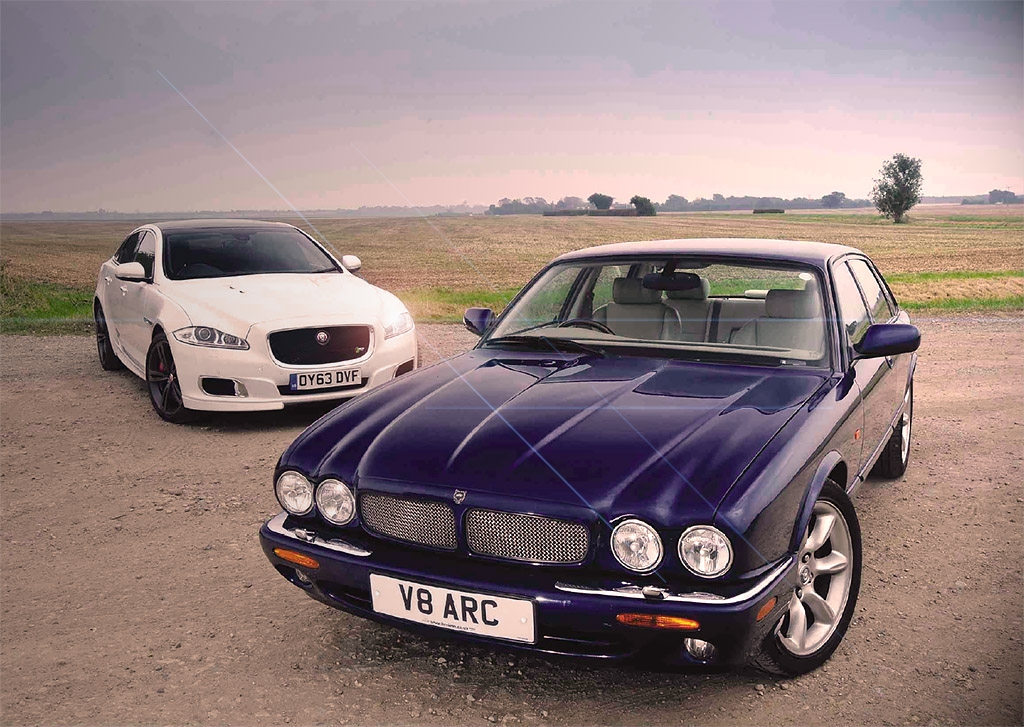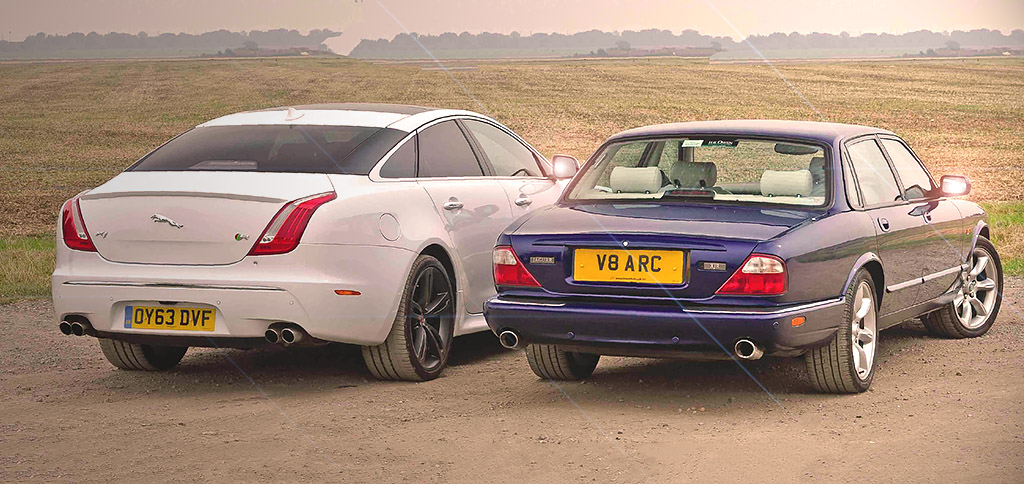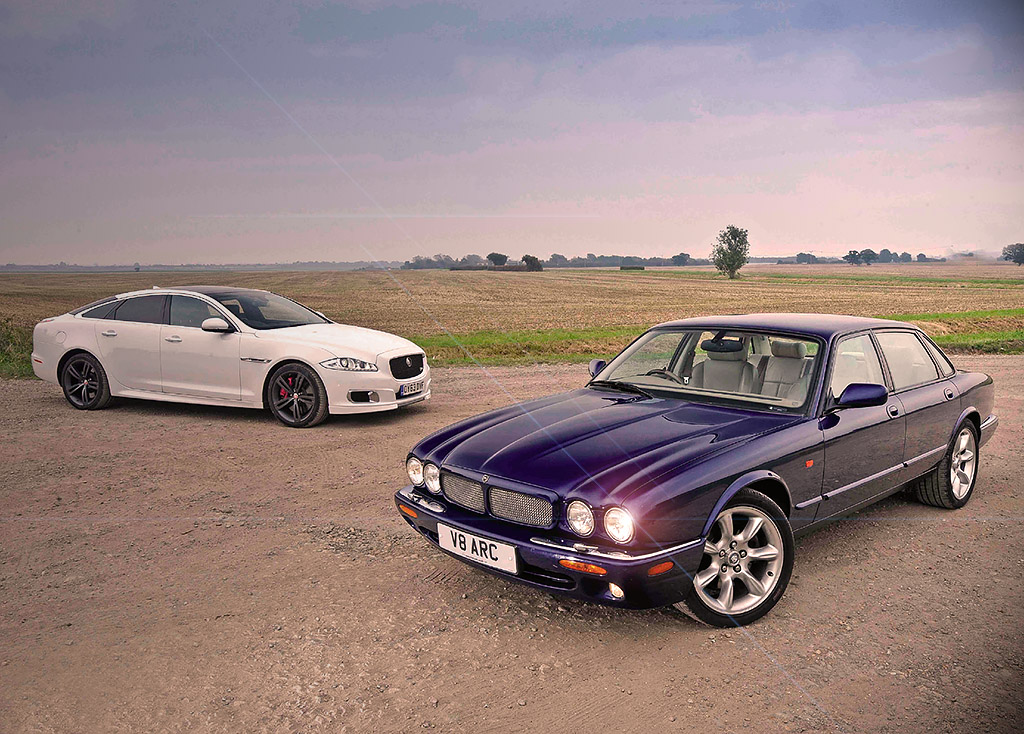
Family ties – twintest – X308 XJR vs X351 XJR – Words Paul Walton. Photography Michael Bailie. As the best-selling model to date, the X308 generation of XJR is considered by many to be the pinnacle of the brand. How does the car compare to its current, more powerful, relative?
To look at, these two cars couldn’t be more different. It’s like comparing a dolphin with a hippopotamus. One is a subtle, graceful gentleman’s carriage and the other is more a hard-core sports car. Yet, like the aforementioned creature cousins, these two Jaguar saloons are actually related. As the first V8-engined version from 1997, the X308 generation of XJR is a not-so-distant relative of the current model, coming from the same lineage of super saloons. Despite being separated by almost 20 years and their many differences in character, can their shared DNA still be felt?

The last couple of generations of the XJR have had such a high profile that it’s easy to think of it as a recent model. However, its history stretches back 26 years, to October 1988, when the origin of the species was revealed at the British Motor Show. This makes the XJR brand longer-lived than the E-type or even the XJS. The first XJR was based on the XJ40 XJ6 3.6 and was considerably different to what we’ve come to expect in 2014. Using aftermarket styling items that had been available for some time via Jaguar’s racing partner, TWR, the modifications were mainly aesthetical. They included new colour-keyed front and rear bumpers, glass-fibre oversills and a small boot spoiler. The four-headlamp treatment of the entry models was adopted because it was thought this gave the car a sportier look. The car was produced by Jaguar and TWR in a joint venture called JaguarSport, and it was hoped that it would appeal to a younger audience. To appease them, new Speedline 16in alloys shod with Pirelli P600 225/55/ZR tyres were fitted and the suspension system was uprated to enhance the car’s handling. The power steering was also modified with harder bushes to provide greater feel and responsiveness. At that point, there were no plans to alter the 3.6-litre engine or its performance.
IT LOOKS AS THOUGH THEY HAVE COME FROM TWO DIFFERENT WORLDS, NEVER MIND MANUFACTURERS
That came in 1992 with the advent of the 4.0-litre version of the straight-six engine. Top-end breathing was improved with a special inlet manifold, high lift camshafts and a remapped engine management system. At the same time, the compression ratio was increased to 9.75:1, all of which raised the power from 235bhp to 251bhp. Top speed went up to 150mph while the 0-60mph time was 6.7 seconds with a manual gearbox, and 7.7 seconds for the automatic. Complete with other aesthetical changes – including flared sills that were integrated into the body – this second generation XJ40 XJR was much cleaner and had the performance to match. These JaguarSport-built cars might not have been commercially successful – just 1,243 were made between 1988 and 1994 – but they raised Jaguar’s profile sufficiently that when the XJ40’s replacement was being developed (the X300), an XJR version was part of the programme from the start.
This one, though, would be very different. To begin with, it was created in-house after Jaguar and TWR severed relations in 1994. More importantly, it was the first XJR (and the first Jaguar) to be supercharged. Wanting more power from the 4.0-litre AJ16 engine for the R (the 6.0 V12 was dismissed as an alternative due to emissions), Jaguar’s engineers investigated forced induction – the cancelled XJ41 project had had twin turbos and they’d been impressed by the results. As these turbos wouldn’t fit under the bonnet, Jaguar looked for an alternative and found it in the shape of a new supercharger built by the American firm Eaton. It worked. The power of the 4.0 straight six was raised from 245bhp to 322bhp, dropping the 0-60mph time from seven to 5.9 seconds. This car did more for Jaguar’s image than any other model from the previous two decades. “Couple the brilliance of the chassis and the engine’s massive urge, with a cabin unsurpassed for sheer class, and you have what must be the goal of every luxury car maker,” said Performance Car magazine in November 1994.

Yet the model only lasted for three years. That wasn’t due to it being unpopular (6,547 had been built in that time), but rather because Jaguar swapped the aging AJ16 engine for its new 4.0-litre V8, giving birth to the X308. The car looked similar to its straight six predecessor, but there were plenty of changes beneath the skin. The front of the frame was stiffened and the B-post reinforced. The central bearing of the divided propeller shaft was also repositioned. An XK8 front suspension with its revised kingpin angle was added to reduce road noise and to sharpen the car’s handling, and it was only available with an automatic gearbox, making it the first XJ not to have the option of a manual transmission. The interior was modernised – out went the XJ40’s plastic dash and in came a new veneer-wrapped binnacle similar to the XK8’s.
Unsurprisingly, the XJR had a supercharged version of the 4.0 V8, increasing power from 290bhp to 370bhp, an almost unheard of figure for a four-door saloon at the time. CATS adaptive suspension, first introduced on the XK8, helped to provide both highspeed stability and city-centre comfort – one tester of the era praised the all-round double-wishbone set-up as a ‘model of refinement’. As much as it was fast – 60mph was reached in 5.3 seconds and it was the first Jaguar to be limited to 155mph – it was also very discreet, with only the now-familiar mesh grille setting it aside from its normal siblings. Little wonder the X308 XJR became the most successful XJR to date, with 15,303 sold between 1997 and 2003.
IT’S NOT OBVIOUS WHAT WOULD COME OUT ON TOP IN A TUGOF-WAR WITH A JUMBO JET
Its replacement – the X350 – followed a similar formula for discreet high performance, but it wasn’t as popular as the X308. Only 7,316 XJRs were built between 2003 and 2009, and that’s despite having the 4.2-litre V8 that increased power to 400bhp in a car that weighed 172kg less due to its aluminium construction. Price was a factor: whereas the X308 XJR had cost £54k, the X350 XJR was more than £60k. Even more importantly, the X350’s overly retro styling didn’t have the grace of its forebear, its larger proportions not being quite as perfect. For many, the X308 generation was (and still is) the pinnacle of the XJR.
But then, after a five-year gap, the current XJR with a staggering 550PS (543bhp) was released in 2013.
No other manufacturer has radically changed the styling of its flagship models, and in such a short space of time, as Jaguar. Put a 15-yearold Mercedes-Benz S-Class (W220) alongside the current model (the W222) and their relationship is clear. Not so the X351 and X308 – it looks as though they have come from two different worlds, never mind manufacturers. The biggest difference is the size of the X351. When the Queen Mary slid into the Clyde in 1934, radio announcer George Blake said Cunard’s grandest ship resembled a ‘great white cliff, terrific and overwhelming’. This is what it’s like to stand next to the current XJR. The Polaris White bodywork of this example seems to stretch on forever, and this car isn’t even the long wheelbase version, a combination that’s unavailable in the UK. It’s also incredibly wide – at 1.9m, the X351’s footprint is similar to the Range Rover’s. Then, there’s the shape. Svelte and coupe like, it has a huge presence and dwarfs the still sizable X308 in every way a car can do.
That’s not to say the older car doesn’t have charisma – it does, bags of it. It might not turn heads like the new car, but the X308 still has a sense of style that isn’t immediately obvious to those not in the know. It’s like wearing a wellcut suit – all the signs of its quality are there, you just have to look for them. The X308’s three-box design – bonnet, roof and boot – is very old fashioned by today’s standards, but it’s beautifully proportioned, more so, in my humble opinion, than the X351 that sometimes feels too big, too over-the-top for its own good. I love the detailing of the X308 too. The thinly woven metal mesh grille has more style than the thicker plastic grille of the new car. The six-spoke alloy wheels of this 2001 example also look great, although I’ve become quite smitten by the X351’s 20in Farallon grey alloys that, with a satin black finish, stand out brilliantly against the white paint. And unusually for Jaguar (often charging extra for the good stuff), they’re a standard fit. I also like the new car’s front splitter, giving the XJR a meaner look than its slower siblings, which helps with stability.
Obviously, the interior is as different as the exterior. It would be easy to dismiss the X308’s interior as too conservative compared to the X351’s modern cabin, but that’s missing the point. When the X308 went on sale in 1997, it was very much Jaguar’s market, plus the three potholes in the veneer for the speedo, rev counter and auxiliary dials were a big step forward compared to the X300’s dated, cheap-looking plastic binnacle that hailed from the XJ40. Aesthetically it still works and many would, perhaps, prefer it to the current car’s very modern cabin, which lacks veneer or any sort of tradition. Its digital dials, chrome accents and huge screen look as though they came from the Orion, NASA’s next generation of spacecraft. Clever and dramatic it may be, but the XJR’s interior isn’t sufficiently different to the lower model’s to warrant the extra money. Apart from the small R logo in the steering wheel, it’s exactly the same as the 3.0 diesel’s. Yes, the interior of the X308 XJR doesn’t feel any different to the 3.2 I drove earlier in the year (JWM, June 2014) but it’s worth £5,000 while the current car has a list price of over £92,000. For that money I’d expect both whistles and bells.
Still, starting the current car is an event in itself. Push the dash-mounted button and, as the digital dashboard flickers into life and the rotary gearselector dial rises out from the centre console, that great big 5.0 V8 ignites. It doesn’t have the deep rumble of the other models with the same 550PS engine (the F-TYPE R Coupé and the XFR-S), but it still sounds fabulous, having a louder exhaust note than the older XJR’s, which is more subdued. Perhaps the X308 is more in keeping with a large Jaguar saloon that historically has always been the definition of subtle – could you imagine an XJ12 Series 3 sounding raucous?
It soon becomes obvious that driving the X351 XJR isn’t like driving your traditional Jaguar saloon. With a 5.0-litre supercharged V8 producing close to 543bhp, its firepower is awesome, scary even. It’s not hard to go sideways simply coming out of a junction or to spin the wheels when setting off, neither an ideal scenario when you’re trying to stay under the radar at the school gates (not that a massive white saloon is the kind of car to stay under the radar at the best of times). Squeeze the throttle even a fraction and, once the fat tyres have found some grip, the acceleration is instant and hard. With the eight-speed ’box changing gear seamlessly, the power delivery is smooth and unabated; not for the first time, I think that something this large really shouldn’t move this quickly.
My favourite moment is when I click the selector all the way around to Sport, and the Dynamic setting is activated. The ’box now changes gear later, allowing the engine to rev harder and for longer, and the car instantly feels sharper, its acceleration faster. Using the steering column gear paddles, at around 50mph I manually change down a couple of gears unleashing more of its 501lb ft of torque, a figure so large it’s not obvious what would come out on top in a tug-of-war with a Jumbo Jet.
The way the big car then accelerates to 75mph is breathtaking, often literally. Taking 2.46 seconds (just 0.06 of a second slower than the F-TYPE R Coupé), I’m pushed backwards with an unnatural force. Concentrating on keeping the car on the black stuff, I find myself forgetting to breathe and begin to get tunnel vision – all I can think about is how quickly everything in the distance is arriving. Driving the XJR briskly is not for the fainthearted and you need to remain constantly alert.
Although the X351 XJR feels light and lithe, a result of its aluminium construction, unlike the diesel or 3.0 SC versions, with the 550PS engine you really come to appreciate the car’s girth. Maybe it’s having so much power that has changed its character, or perhaps it’s the extra weight (it weighs 115kg more than the 3.0 SC), but I couldn’t drive it with the fluidity I have done the less powerful models.
Its suspension may have been retuned on the legendary Nürburgring, yet the modern XJR has retained some of the standard model’s suppleness, not feeling as hard or as stiff as the bone-jarring XFR-S. So, at slow speeds, it still soaks up the bumps in the way a large saloon should, but it’s too soft for a car with this much power. Despite having Jaguar’s Adaptive Dynamics system (which actively controls vertical body movement, roll and pitch rates), drive over a series of undulations at speed and the car feels unstable.
However, thanks to an active electronic differential – which can apply torque almost instantaneously when necessary – corners are a real hoot. With the traction control still activated (only a driving god or a total nutter would turn it off), it allows for a little slip but it’s always expected and easy to correct.
It is, in other words, a hardcore sports car, only one with a sensible boot. The X308, by comparison, is a very different animal. Whereas the original V8-engined XJR retains the gracefulness that Jaguars of old were synonymous for, the X351 is more about brute force. It’s not that the X308 isn’t fast – with a 0-60mph time of 5.3 seconds, it is – but putting your foot down never results in a feeling of regret, that perhaps you shouldn’t have pressed the go pedal with quite so much vigour. And, unlike the XJ40 and X300 generations of XJR I’ve driven, pressing the Sport button actually does more than simply illuminating a bulb – its performance becomes sharper, edgier, more focused. Its power is much more attainable, more real world than the bombastic X351.
The X308 differs even more from the 5.0 version in its handling. Constructed from steel, it feels much heavier than its younger sibling, although it’s actually the same weight, just smaller. Lacking the agility of the aluminium XJR, it’s not as easy to scythe through corners. On the plus side, the ride is still first rate and, on the same road that made the other car unstable, it always felt 100 percent planted to the asphalt.
The pair of XJRs are as different as two cars can be. But that’s not a bad thing. They come from two completely different periods in Jaguar’s history, and the X351 represents almost two decades of progress. Love or loath the car, every company needs to move on. It does mean, though, that they don’t feel as if they have come from the same lineage. Badge and V8 engines aside (but even these sound and perform very differently), like the dolphin and its long-lost, land-based cousin, there’s not much that ties these cars together any more.
THANKS TO:
Arthur Clapham for the use of his 2001 XJR and Nene Jag Specialists (www. nenejags. co. uk) for finding it.
|
2001 XJR 4.0 Engine 3996cc V8 SC Power 370bhp Torque 387lb ft 0-60mph 5.3secs Top speed 155mph Transmission 6-speed auto Economy 22.4mpg Kerb weight 1,837kg Price new £51,950 Value now £5,000 |
2014 XJR 5.0 Engine 5000cc V8 SC Power 543bhp Torque 501lb ft 0-60mph 4.4secs Top speed 174mph Transmission 8-speed auto Economy 24.4mpg Kerb weight 1,870kg List price £92,395 Price as tested £96,425 |
Below left: With 543bhp, the 5.0 supercharged V8 makes the X351 very fast. This car has an optional Below right: The interior of the current car is very modern but perhaps not special enough for a £92k car
Above: The X308 generation of XJR still looks beautifully proportioned and looks fabulous on the 18in Asteroid alloy wheels Bottom left: The X308’s interior looks old fashioned compared to the X351’s but it’s still comfortable Bottom right: With 370bhp, the 4.0 supercharged V8 doesn’t have the same firepower as the 5.0 in the current car but it’s still quick
IT MIGHT NOT TURN HEADS LIKE THE NEW CAR, BUT THE X308 STILL HAS A SENSE OF STYLE





